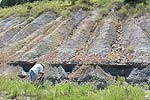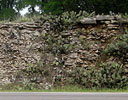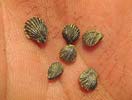|
Stratigraphy of the Pennsylvanian Formations of North-Central Texas
Palo Pinto Formation
" Name and Stratigraphic Position. — At the base of the
Canyon group in the Brazos River Valley and lying with apparent conformity
upon the shales and sandstones of the Strawn is a bed of massive limestone
which varies in thickness from 50 to 100 feet. This is named the Palo
Pinto limestone from the town of Palo Pinto located on its outcrop. It may
be recognized easily elsewhere in well logs and in the field because it is
the lowermost thick limestone in the section above the Strawn sands.
Lithologic Character. — The Palo Pinto limestone is a
thick, crystalline, dark-gray limestone weathering white or grayish
yellow. In many places the lower portion is made up of many thin beds from
two to six inches thick, separated by partings of gray marl so that in
weathering the rock shelves off into great piles of slabs, chips, and
chunks. The upper layers are thicker, dark gray, fine-grained,
even-textured, more fossiliferous, and purer than the lower beds. Upon
weathering these beds break into large blocks and irregular chunks.
"
Paleontology. — The faunal character of the Palo Pinto
limestone has not been indicated satisfactorily in the course of the field
work on the Texas Pennsylvanian. The collections are rather meager and for
the most part contain only the more common, long-ranging Pennsylvanian
types. The limestone is not on the whole very fossiliferous and there has
not been opportunity for special paleontological investigation of this
horizon. So far as observed the fossils are contained chiefly in the upper
portion of the limestone above the parting of yellow shale which divides
the formation into two main ledges.
Perhaps the chief characteristic of the Palo Pinto fossils is their robust
appearance. Species which at other stratigraphic horizons have only
moderate size, appear here as very large individuals which in some cases
are almost twice the normal size. Most of the specimens, also, are very
perfectly formed and well preserved. "
|










